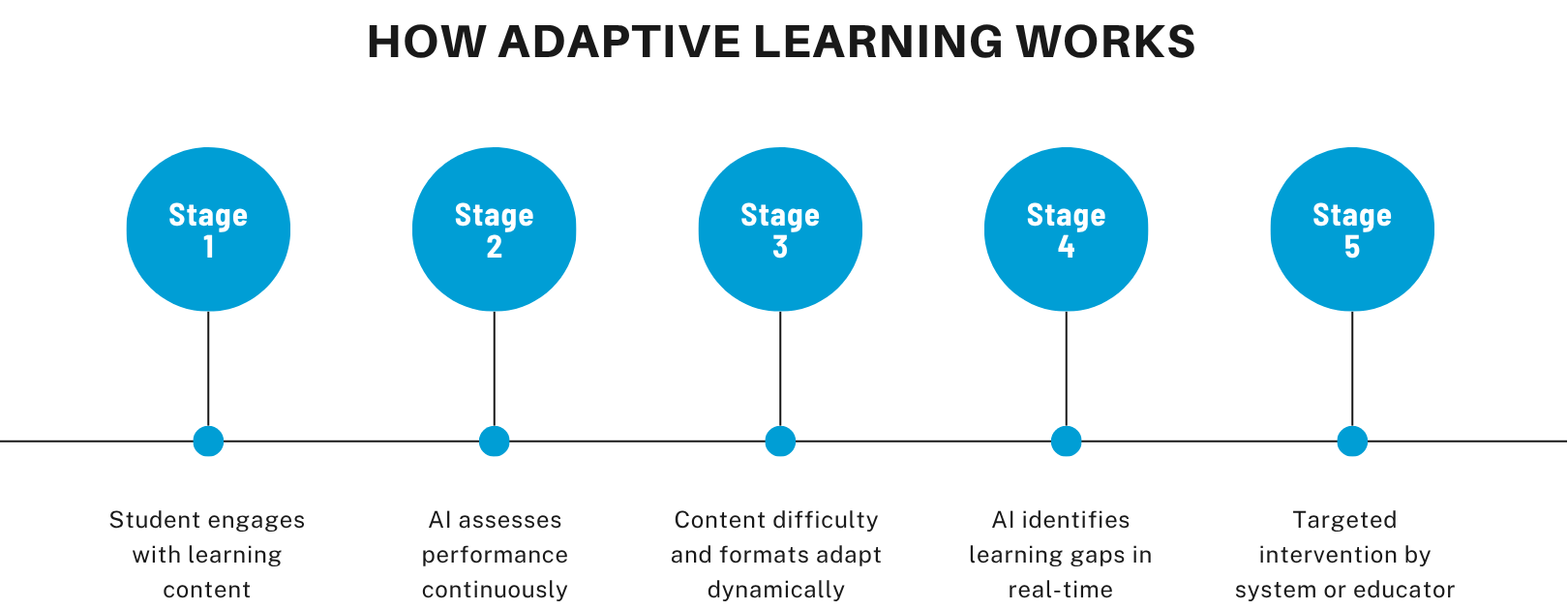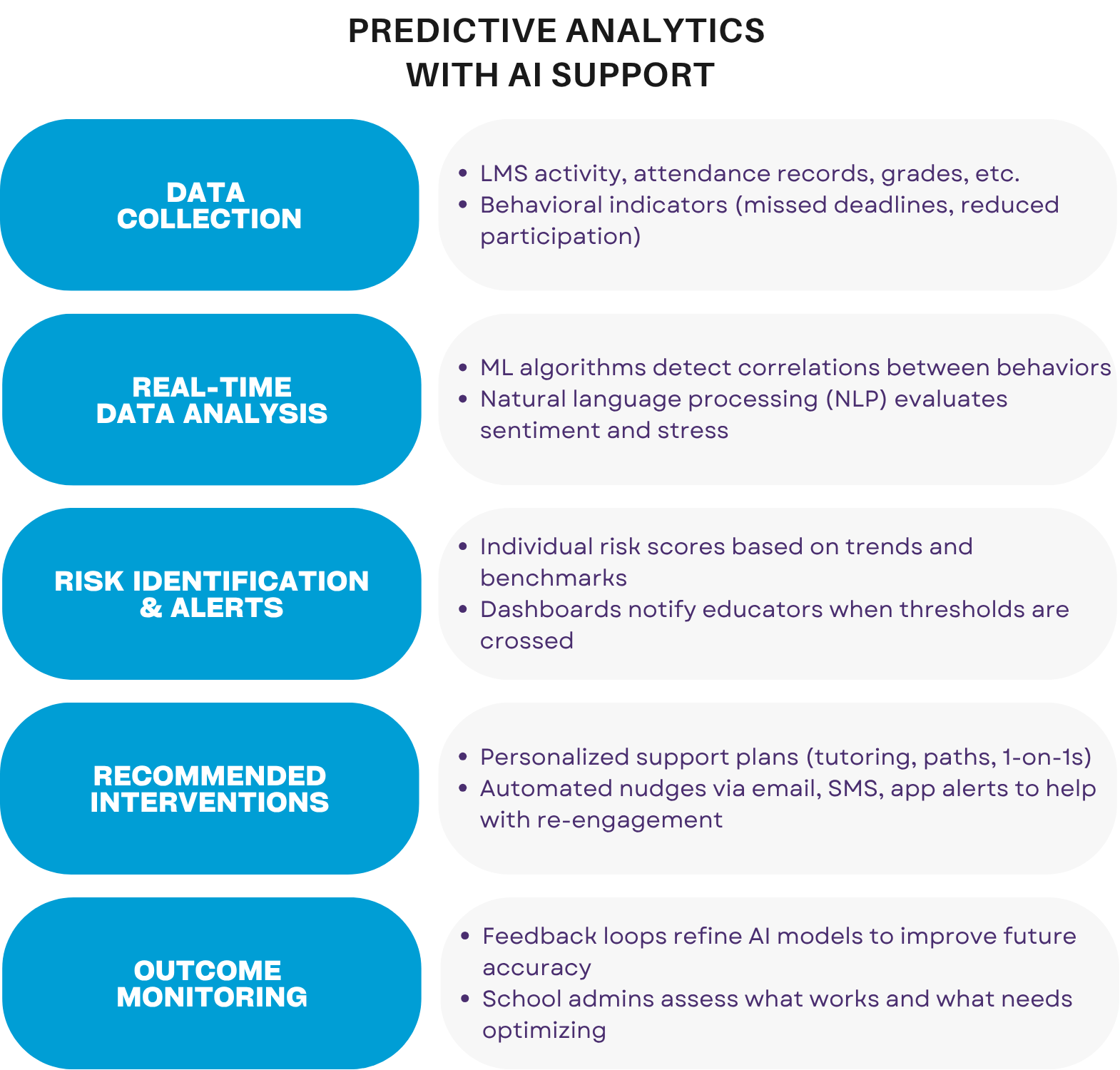Artificial intelligence is rapidly becoming an integral part of education. What started as a collection of experimental tools like virtual tutors, smart chatbots, and adaptive quizzes has evolved into a powerful ecosystem that is redefining how students learn, how teachers teach, and how institutions manage their operations.
From on-demand learning assistance to personalized study paths and predictive analytics, AI software development for education is moving beyond novelty and becoming a cornerstone of modern learning and teaching strategies. Schools, universities, and e-learning platforms are embracing AI to deliver more tailored, efficient, and scalable learning experiences.
In this article, we explore the key ways AI is shaping the future of education, highlighting innovations like virtual tutors, adaptive learning systems, performance analytics, and more. We’ll also touch on the challenges and ethical considerations that come with this technological shift.

Virtual Tutors and AI-Driven Learning Assistants
AI-powered virtual tutors are among the most visible and impactful innovations in modern education. These tools act as on-demand learning companions, offering instant support, explanations, and feedback across a wide range of subjects. Whether it’s helping a student understand complex math equations or guiding them through language exercises, AI tutors extend learning beyond the classroom, anytime and anywhere.
On-Demand Help for Students
Virtual tutors and AI-driven learning assistants are designed to mimic the responsiveness of a human teacher while operating at scale. Students can ask questions, receive real-time answers, and work through practice problems without waiting for teacher availability. This kind of 24/7 access to guidance is particularly valuable in self-controlled e-learning environments and for students in remote or underserved areas.
Examples include:
- Language learning apps with conversational AI (e.g., chatbots that simulate real-life dialogues)
- Math and science tutors that provide step-by-step explanations
- Homework help platforms that use AI to analyze student queries and deliver precise assistance
Chatbots & Conversational AI in Classrooms
AI-driven chatbots are increasingly being integrated into classroom environments as supportive tools for both students and teachers. These solutions can answer frequently asked questions, provide lesson summaries, and even assist with scheduling and reminders. By automating routine queries and tasks, chatbots allow teachers to focus on higher-value interactions such as personalized instruction and student mentorship.
Moreover, conversational AI is being used to:
- Reinforce lessons through interactive Q&A
- Provide accessibility support (speech-to-text and multilingual translation)
- Encourage engagement through gamified learning interactions
Personalized Learning Paths
One of AI’s most transformative impacts on education is its ability to tailor learning experiences to the unique needs and pace of each student. Traditional education models often which often follow a one-size-fits-all approach with varied personalization, mostly based on how much effort each teacher puts in. AI-powered learning systems can adapt dynamically, providing customized content, pacing, and support to maximize learning outcomes.

Adaptive Learning Algorithms
At the core of personalized learning are adaptive algorithms that continuously assess a student’s progress and adjust the curriculum accordingly. These tools track how quickly a student grasps new material, where they struggle, and how they interact with content.
Based on this data, AI can:
- Present materials in different formats (e.g., video, text, interactive quizzes)
- Adjust the difficulty of assignments in real-time
- Recommend supplementary resources to reinforce weak areas
Bridging Learning Gaps
AI’s ability to spot learning gaps early is one of its most powerful features. Rather than waiting for standardized tests or periodic assessments, custom AI software can flag underperformance as soon as patterns emerge. This allows educators to:
- Intervene with targeted support (tutoring, extra exercises)
- Personalize feedback and guidance
- Prevent small misunderstandings from growing into major obstacles
By addressing learning challenges promptly, AI helps create a more equal educational environment by ensuring that no student is left behind due to unnoticed struggles.
Predictive Analytics in Student Performance
Beyond enhancing the learning process, AI also plays a critical role in forecasting student performance and outcomes. By analyzing large volumes of data, including attendance, engagement metrics, and assessment results, AI-driven predictive analytics help educators make proactive, data-informed decisions that can improve student success rates.

Early Warning Systems
Predictive models can identify patterns that signal when a student is at risk of falling behind, failing a course, or even dropping out. These early warning systems provide educators with timely alerts, allowing them to intervene before challenges become critical. Key features include:
- Real-time risk scoring for individual students
- Automated recommendations for intervention strategies
- Continuous monitoring of academic and behavioral data
Data-Driven Decision Making for Educators
AI’s predictive power provides valuable insights for administrators and teachers seeking to improve curriculum design, teaching strategies, and resource allocation. This is already implemented in many platforms to a varying degree of relying on AI. LMS and e-learning tools with elements of AI can perform a magnitude of activities to simplify and enhance the process. For example:
- Spotting trends in class-wide performance to refine lesson plans
- Identifying systemic barriers affecting specific student groups
- Optimizing the allocation of support staff or tutoring resources
With AI-powered analytics, educators can base their decisions on evidence rather than assumptions, driving continuous improvement across the learning ecosystem.
Automating Administrative and Assessment Tasks
AI’s impact on education also plays a significant role in streamlining administrative tasks and assessment processes. By automating time-consuming and repetitive work, AI allows educators and administrators to focus on what matters most: teaching and student development.
Grading Automation
One of the most practical applications of AI is in automating grading and assessment. Modern AI software can evaluate not only multiple-choice or structured responses but are also increasingly capable of:
- Grading essays and written assignments with natural language processing (NLP)
- Assessing creative work through pattern recognition (code reviews, design critiques)
- Providing instant, detailed feedback to students
Administrative Efficiency
Educational institutions deal with a wide range of back-office tasks that are ripe for automation. AI can:
- Manage scheduling and room assignments
- Track attendance and generate reports
- Streamline admissions and enrollment processes
- Handle communication workflows like reminders and notifications
By automating these administrative duties, AI helps institutions optimize resources, minimize human error, and improve overall operational efficiency.
Ethical Considerations and Challenges
As AI becomes more embedded in education, it’s essential to address the ethical implications and potential risks that come with its adoption. While the benefits are significant, AI also introduces new challenges that require careful oversight and responsible implementation.
Data Privacy and Security
AI systems rely on vast amounts of student data, ranging from personal information to academic performance metrics. This raises critical concerns around several aspects, including data protection and compliance with regulations like GDPR and local privacy laws. The level of complexity and care that has to be put into solutions like that often matches healthcare regulations in terms of security and data storage approach.
Secure data storage and access controls to prevent unauthorized use are also two critical parts that AI software development companies have to take into account while developing AI solutions for education. The same goes for transparency around how student data is collected, processed, and used.
Educational institutions must prioritize data privacy by design when implementing AI solutions, ensuring that trust and safety remain at the forefront.
Equality and Accessibility
Another key ethical consideration is the risk of deepening educational inequalities. Not all students have equal access to digital infrastructure, and poorly designed AI systems can unintentionally:
- Reinforce biases present in training data
- Exclude students with disabilities if accessibility is not factored in
- Widen the gap between well-funded institutions and those with fewer resources
To maximize AI’s positive impact, educational stakeholders need to commit to inclusive, bias-aware design and ensure that AI-driven tools are accessible to all learners.
The Takeaway
AI has become a driving force behind more personalized, efficient, and scalable learning experiences. From virtual tutors and adaptive learning paths to predictive performance insights and administrative automation, AI is enhancing the way students, teachers, and institutions approach learning and development.
However, meaningful adoption requires a thoughtful balance between innovation and responsibility. As AI tools continue to evolve, education leaders must prioritize data privacy, equity, and long-term adaptability to ensure that technology serves every learner effectively.
At SEVEN, we help educational organizations harness the full potential of custom AI solutions, designed to integrate seamlessly, scale with confidence, and meet your unique needs. Explore our AI Development Services to learn more.